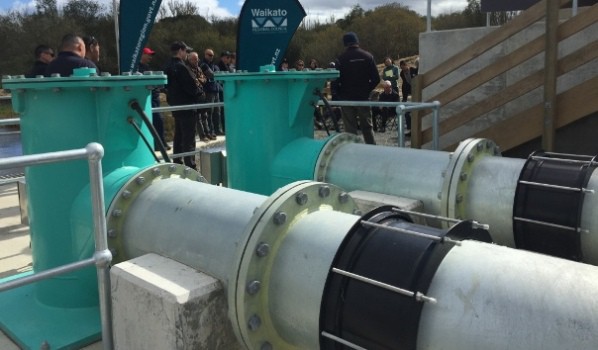Waikato Regional Council news
Waikato Regional Council is optimistic new national fish friendly guidelines announced this week will be accompanied by Government and research institute investment in solutions to this increasingly challenging issue.
The council is seeking partnerships nationwide to undertake its own significant research and development project to trial different approaches to improving fish passage currently impacted by flood protection infrastructure.
New Zealand’s first ‘fish friendly’ pumps at Te Kauwhata, in north Waikato, were officially opened yesterday in a ceremony to coincide with Saturday’s World Fish Migration Day.
At the opening regional council chair Alan Livingston acknowledged that many of the region’s flood pumps date back to the 1960s and were installed when there wasn’t the understanding there is today of the impact on aquatic ecology and native fish migration.
“This issue is not unique to the Waikato, so it does require a consistent national approach. But we do have the largest number of flood pumps in New Zealand and so it seems only fitting that we are leading the way by installing the country’s first, imported, fish friendly pump.
“The design, construction and science that has gone into the Orchard Rd pump station forms a significant part of a wider, three year research project being considered in our 10 year plan.
“This project will investigate a range of possible solutions to improve fish migration through our flood protection assets. The project won’t just trial fish friendly pumps – it will look at other technological solutions to address this problem across our Lower Waikato, Waihou and Piako zones.
“We are very much promoting a collaborative effort, together with our regional council counterparts around New Zealand who, like us, are looking to the outcomes to guide future investments. We hope that research institutes and the Government will support our initiative with technical expertise and funding,” Cr Livingston said.
Waikato Regional Council scientists formed part of the New Zealand Fish Passage Advisory Group, which worked with the Department of Conservation (DOC) and NIWA to develop the national fish passage guidelines announced on Wednesday.
The Minister of Conservation, Eugenie Sage, launched the document to over 100 ecologists, engineers and others from 50 organisations representing regional councils, Fish and Game, DOC, the Ministry for the Environment and others involved in fish passage management in New Zealand.
The national fish passage guidelines will inform the planning, design, construction, management and monitoring of structures up to 4 metres high in waterways.
“We should all benefit from a consistent national approach to fish passage and instream structure management in New Zealand to achieve better outcomes for our native fish,” Cr Livingston said.
ORCHARD ROAD PUMP STATION
The Orchard Rd pump station opening was attended by local landowners, kaumatua and representatives from Ngā Muka and Waikato-Tainui, as well as a number of other organisations and council staff involved in the pump station’s construction.
The two year project to replace the pump station was completed in late 2017. The work was prioritised by the council in response to concerns raised by local landowners over the underperformance of the pumps due to peat consolidation and ground settlement, as well as health and safety design issues for operational staff at the structure.
It was also recognised that the council had a responsibility to protect and promote biodiversity and cultural values and that there were fish passage issues at the site which needed to be addressed.
The new Bedford fish friendly pumps increase the survival of fish by using a screw-shaped impellor with rounded blades that have a lower risk of striking and cutting fish.
Monitoring of the old and new pumps at Orchard Road using live tagged eels has shown a dramatic increase in large eel survival – from 0 per cent to 95 per cent.
